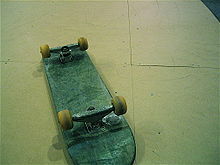- Masonite
-
 1944 Quebec license plate made of masonite. This was done due to metal conservation during World War II.
1944 Quebec license plate made of masonite. This was done due to metal conservation during World War II.
Masonite is a type of hardboard invented by William H. Mason.[1]
Contents
History
Masonite was invented in 1924 in Laurel, Mississippi, by William H. Mason.[2] Mass production started in 1929. In the 1930s and 1940s Masonite was used for many applications including doors, roofing, walls, desktops,[3] and canoes. It was sometimes used for house siding; if kept painted at regular intervals, it will last the life of the house.[citation needed]
Similar "tempered hardboard" is now a generic product made by many forest product companies. The Masonite Corporation entered the door business as a supplier of facings in 1972,[4] and was purchased in 2001 by Premdor Corporation, a door maker, from its former parent International Paper; it no longer supplies generic hardboard.
Production
Masonite is formed using the Mason method,[5] in which wood chips are disintegrated by saturating them with 100psi steam, then increasing the steam or air pressure to 400psi and suddenly releasing them through an orifice to atmospheric pressure. Forming the fibers into boards on a screen, the boards are then pressed and heated to form the finished product with a smooth burnished finish. (Later a dry process with two burnished surfaces was also used.) The original lignin in the wood serves to bond the fibers without any added adhesive. The long fibers give Masonite a high bending strength, tensile strength, density and stability. Unlike other composite wood panels, no formaldehyde-based resins are used to bind the fibers in Masonite.
Use
Artists have often used it as a support for painting,[6] and in artistic media such as linocut printing. Masonite's smooth surface makes it a suitable material for table tennis tables and skateboard ramps. Masonite is also popular among theater companies as an inexpensive way to resurface stage floors.
Moving companies are large users of Masonite. Among other things, they use it to protect the walls of buildings they are working in, and lay it on floors to enable smooth rolling of dollies loaded with goods.
Masonite is widely used in construction, particularly in high-end renovations where floors are finished prior to other work and require protection. Sheets of ⅛" or ¼" Masonite are typically laid over rosin paper on finished floors to protect them. The Masonite sheets are taped together with duct tape to prevent shifting and to keep substances from leaking through.
Masonite is also used extensively in the construction of sets for theater and film and television. It is especially common in theaters as the stage floor, painted matte black.
It is also considered one of the best materials in the making of a musical wobble board.
Masonite is also a popular choice for cake boards for professional cake decorators, due to its being a natural product and being strong enough to support multiple tiered creations, such as wedding cakes.
In Europe, this product is also known as Isorel.
To a lesser extent, Masonite is used in guitar bodies, most notably by Danelectro.
Masonite was also a popular protective backing for wooden console stereo and television cabinets, from the 1960s to the 1980s.
Deterioration
Masonite swells and rots over time when exposed to the elements, and may prematurely deteriorate when it is used as exterior siding. In 1996, International Paper (IP) lost a class action suit brought by homeowners whose Masonite siding had deteriorated. The jury found that IP's Masonite siding was defective. [7]
See also
- Masonite International
- Engineered wood
- Fiberboard
- Glued laminated timber
- Hardboard
- Medium-density fiberboard
- Oriented strand board
- Particle board
- Plywood
- Pressed wood
- Wobble board
References
- ^ [1]
- ^ "1925 - Masonite Europe". Masonite Europe<!. http://www.masonite-europe.com/netbuildpro/process/23/1925.html. Retrieved 2009-09-23.
- ^ http://en.wikipedia.org/wiki/Danelectro
- ^ "The History of Masonite". http://www.masonite.com/masonite_history.php.
- ^ U.S.Patents 1,578,609 & 1,586,159
- ^ "MoMA Museum Presents the First Major Exhibition to Focus on the Transformative Decade of Joan Miró's Work between 1927 and 1937" - press release by the exhibition "Miró: Painting and Anti-Painting 1927-1937" in the Museum of Modern art in New York (MoMA) in 2008-2009, the section works on masonita, p. 6.
- ^ "Jury finds International Paper's Masonite siding defective". Thefreelibrary.com. 1996-09-13. http://www.thefreelibrary.com/Jury+finds+International+Paper%27s+Masonite+siding+defective.-a018674180. Retrieved 2009-09-23.
External links
Categories:
Wikimedia Foundation. 2010.



